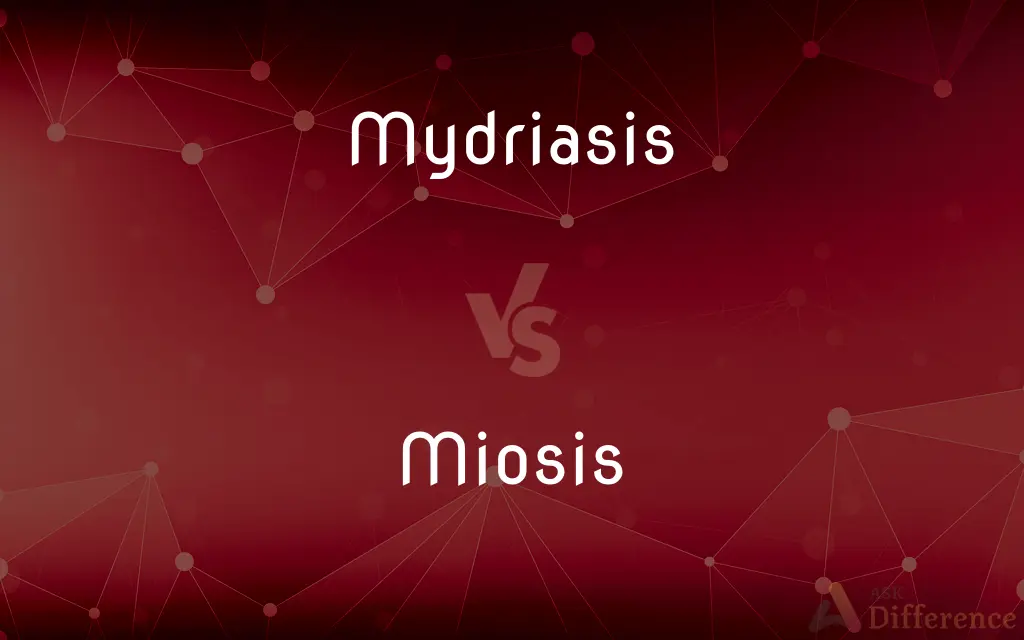Mydriasis vs. Miosis — What's the Difference?
By Fiza Rafique & Urooj Arif — Updated on April 7, 2024
Mydriasis refers to the dilation of the pupil, enhancing light entry, while miosis signifies pupil constriction, reducing light exposure.

Difference Between Mydriasis and Miosis
Table of Contents
ADVERTISEMENT
Key Differences
Mydriasis is a condition where the pupils are dilated, allowing more light to enter the eye, which can be caused by low light conditions, certain medications, or neurological damage. Miosis, on the other hand, involves the constriction of the pupils, decreasing the amount of light that enters the eye, and is often a response to bright light, certain drugs, or as a part of the normal aging process.
In situations requiring enhanced vision in dim lighting, mydriasis naturally occurs to improve visual acuity by admitting more light into the eye. Conversely, miosis serves as a protective mechanism in bright lighting conditions, reducing the risk of retinal damage by limiting light entry.
Pharmacologically induced mydriasis is often employed during eye examinations to provide a better view of the eye's interior, facilitating accurate diagnosis of conditions like cataracts or retinal detachment. Whereas, miosis can be induced for therapeutic reasons, such as treating glaucoma by decreasing intraocular pressure through minimized pupil size.
Certain systemic conditions, such as a brain injury or adrenal gland dysfunction, can lead to mydriasis by disrupting normal autonomic nervous system function. Miosis can similarly indicate systemic issues, such as opioid overdose or exposure to nerve agents, reflecting the body's exposure to toxic substances or severe systemic stress.
Understanding the underlying causes of mydriasis and miosis is crucial in clinical settings, as these conditions can be symptoms of more serious health issues requiring immediate attention. While mydriasis might suggest a need for neurologic evaluation, miosis could signal toxic exposure or the need for emergency treatment for conditions like glaucoma.
ADVERTISEMENT
Comparison Chart
Definition
Dilation of the pupil
Constriction of the pupil
Primary Cause
Low light, drugs, neurological damage
Bright light, certain drugs, aging
Function
Increases light entry into the eye
Decreases light entry into the eye
Pharmacological Use
Eye examinations, diagnosis of eye conditions
Treatment of conditions like glaucoma
Indicative of
Systemic or neurological issues
Toxic exposure, systemic stress, glaucoma
Compare with Definitions
Mydriasis
Associated with excitement or fear response.
She experienced mydriasis during the horror movie.
Miosis
May indicate aging or glaucoma.
His miosis was more pronounced, a sign of his advancing age.
Mydriasis
Can be induced by medications or injury.
The patient's mydriasis was due to the administration of atropine.
Miosis
Can result from opiate use or exposure to nerve agents.
Miosis in the patient suggested opioid overdose.
Mydriasis
Dilation of the pupil to increase light entry.
Mydriasis enhances vision in dim light.
Miosis
Part of the eye's protective response to bright light.
Automatic miosis protects the retina outdoors.
Mydriasis
Used diagnostically in medicine.
Mydriasis was induced for a thorough retinal examination.
Miosis
Constriction of the pupil to decrease light entry.
Miosis occurs when stepping into bright sunlight.
Mydriasis
May indicate neurological damage.
The doctor noted mydriasis, suspecting a brain injury.
Miosis
Therapeutically induced in eye treatments.
Miosis was induced to reduce the patient's intraocular pressure.
Mydriasis
Mydriasis is the dilation of the pupil, usually having a non-physiological cause, or sometimes a physiological pupillary response. Non-physiological causes of mydriasis include disease, trauma, or the use of drugs.
Miosis
Miosis, or myosis, is excessive constriction of the pupil. The term is from Ancient Greek μύειν mūein, "to close the eyes".
Mydriasis
Dilation of the pupil of the eye, especially when excessive or prolonged, usually as a result of trauma, a medical disorder, or a drug.
Miosis
Constriction of the pupil of the eye, resulting from a normal response to an increase in light or caused by certain drugs or pathological conditions.
Mydriasis
(medicine) The condition of having abnormally large and dilated pupils due to illness or narcotics, particularly stimulants such as methamphetamine, cocaine, etc.
Miosis
Of the pupil of the eye.
Mydriasis
A long-continued or excessive dilatation of the pupil of the eye.
Miosis
(rhetoric) Litotes; diminution.
Mydriasis
Reflex pupillary dilation as a muscle pulls the iris outward; occurs in response to a decrease in light or certain drugs
Miosis
Reflex contraction of the sphincter muscle of the iris in response to a bright light (or certain drugs) causing the pupil to become smaller
Common Curiosities
Can mydriasis be intentionally induced?
Yes, mydriasis can be pharmacologically induced during eye exams to better inspect the interior of the eye.
What causes mydriasis?
Mydriasis can be caused by low light conditions, certain medications, or neurological damage.
What is the main purpose of miosis?
The main purpose of miosis is to protect the eye from excessive light, potentially reducing the risk of retinal damage.
How do mydriasis and miosis differ in their response to light?
Mydriasis occurs in response to low light to improve vision, whereas miosis occurs in bright light to protect the eye.
How does miosis affect vision?
Miosis reduces the amount of light entering the eye, which can limit vision in dimly lit conditions.
Can aging affect the pupil's response to light?
Yes, aging can lead to miosis, affecting the pupil's ability to dilate in response to changes in light.
Can both mydriasis and miosis indicate health issues?
Yes, both can be symptoms of underlying health problems, including systemic diseases or exposure to toxic substances.
Is mydriasis associated with any emotional responses?
Mydriasis can be associated with fear or excitement, resulting in dilated pupils.
What does persistent mydriasis indicate?
Persistent mydriasis may indicate serious neurological damage or dysfunction requiring medical evaluation.
How is miosis induced for therapeutic purposes?
Miosis can be induced using specific medications to treat conditions like glaucoma by reducing intraocular pressure.
What role does the autonomic nervous system play in mydriasis and miosis?
The autonomic nervous system regulates both mydriasis and miosis, controlling pupil size based on environmental and physiological factors.
Is there a difference in how mydriasis and miosis are treated?
Treatment varies based on the underlying cause, with mydriasis sometimes requiring neurologic evaluation and miosis potentially indicating toxicology or emergency glaucoma treatment.
How does bright light trigger miosis?
Bright light activates the eye's reflexes, signaling the muscles to constrict the pupil and limit light entry, protecting the retina.
What precautions should be taken if experiencing sudden mydriasis or miosis?
Sudden changes in pupil size should prompt immediate medical consultation to rule out serious conditions or underlying health issues.
Can miosis be reversed?
Miosis caused by drugs or temporary conditions can be reversed, while that caused by aging or chronic conditions may be irreversible.
Share Your Discovery

Previous Comparison
Naphthalene vs. Camphor
Next Comparison
Multip vs. PrimipAuthor Spotlight
Written by
Fiza RafiqueFiza Rafique is a skilled content writer at AskDifference.com, where she meticulously refines and enhances written pieces. Drawing from her vast editorial expertise, Fiza ensures clarity, accuracy, and precision in every article. Passionate about language, she continually seeks to elevate the quality of content for readers worldwide.
Co-written by
Urooj ArifUrooj is a skilled content writer at Ask Difference, known for her exceptional ability to simplify complex topics into engaging and informative content. With a passion for research and a flair for clear, concise writing, she consistently delivers articles that resonate with our diverse audience.















































